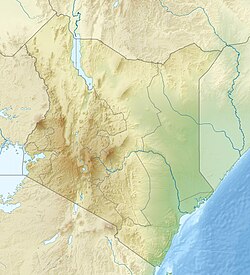Nairobi National Park
| Nairobi National Park | |
|---|---|
|
IUCN category II (national park)
|
|
|
Location of Nairobi National Park
|
|
| Location | Kenya |
| Nearest city | Nairobi |
| Coordinates | 1°22′24″S 36°51′32″E / 1.37333°S 36.85889°ECoordinates: 1°22′24″S 36°51′32″E / 1.37333°S 36.85889°E |
| Area | 117.21 km2 (45.26 sq mi) |
| Established | 1946 |
| Governing body | Kenya Wildlife Services |
Nairobi National Park is a national park in Kenya. Established in 1946, the national park was Kenya's first. It is located approximately 7 kilometres (4 mi) south of the centre of Nairobi, Kenya's capital city, with an electric fence separating the park's wildlife from the metropolis. Nairobi's skyscrapers can be seen from the park. The proximity of urban and natural environments has caused conflicts between the animals and local people and threatens animals' migration routes.
Still, despite its proximity to civilisation and relative small size for an African national park, Nairobi National Park boasts a large and varied wildlife population. Migrating herbivores gather in the park during the dry season, and it is one of Kenya's most successful rhinoceros sanctuaries.
Colonists arrived in the area where the park is located in the late 19th century. At this time, the Athi plains east and south of what is today Nairobi had plentiful wildlife. Nomadic Maasai lived and herded their cattle among the wildlife. Kikuyu people farmed the forested highlands above Nairobi. As Nairobi grew—it had 14,000 residents by 1910—conflicts between humans and animals increased. Residents of the city carried guns at night to protect against lions. People complained that giraffes and zebras walked on and ruined their flower beds. Animals were gradually confined to the expansive plains to the west and south of Nairobi, and the colonial government set this area aside as a game reserve. Settlers from Nairobi including Isak Dinesen, author of Out of Africa, rode horses among gazelles, impala, and zebras in this reserve.
The conservationist Mervyn Cowie was born in Nairobi. Returning to Kenya after a nine-year absence in 1932, he was alarmed to see that the amount of game animals on the Athi plains had dwindled. Expanding farms and livestock had taken the place of the game. He later recalled this place as a paradise that was quickly disappearing. At this time, the area that would later become Nairobi National Park was part of the Southern Game Reserve. Hunting was not permitted in the reserve, but nearly every other activity, including cattle grazing, dumping, and even bombing by the Royal Air Force was allowed. Cowie started to campaign for the establishment of a national park system in Kenya. The government formed a committee to examine the matter.
...
Wikipedia

